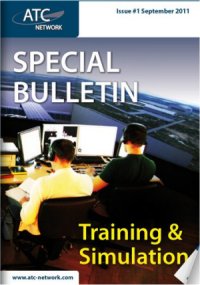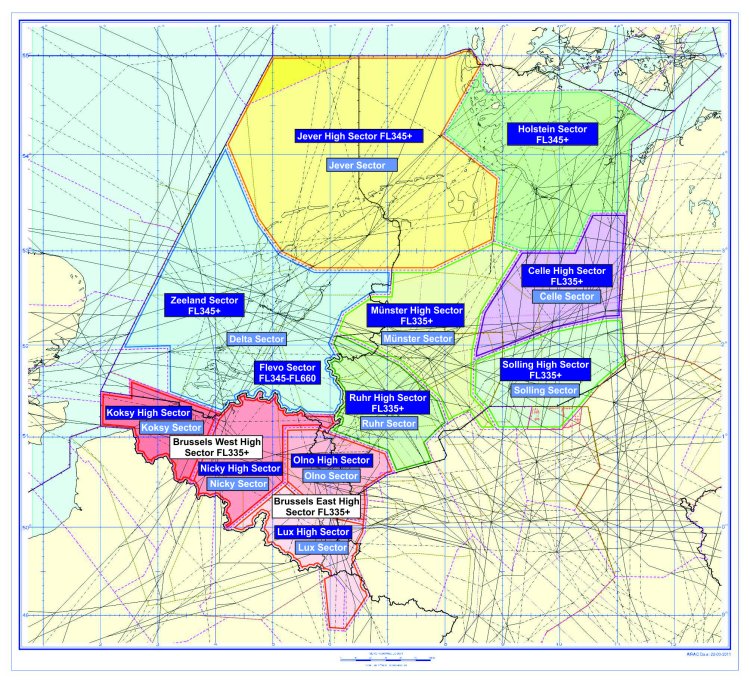
This article originally appeared in the ATC Network Special Bulletin 'Training and Simulation - September 2011. To read the complete publication go to:
http://www.atc-network.com/training
Chris Wade, ATC Network
http://www.atc-network.com/training
Chris Wade, ATC Network
After we decided to dedicate a Bulletin Special to ATC Training and Simulation I enquired with Maastricht Upper Area Control Centre (MUAC) if I could visit their Simulator. I started my own career in ATC at Eurocontrol. Arriving at the Luxembourg Institute of Air Navigation Services (IANS) in 1994 Ab-Initio 20 followed 6 months of intense study and simulation training. Following that, we had to re-locate to Maastricht in the Netherlands for 6 months. Here we learnt the airspace routes of the MUAC by drawing the airspace routes over and over again. As well as learning the job of a Flight Data Assistant, a job which is now largely automated. Another 6 months in Luxembourg followed, Simulation and theory, after which we would return to Maastricht for the final training.
This was the training from 15 years ago and now quite a lot has changed. The operations room we used in Maastricht is now the simulator and the controllers at the MUAC are now working in an operations room which is arguably one of the most advanced in the ATC world.
This was the training from 15 years ago and now quite a lot has changed. The operations room we used in Maastricht is now the simulator and the controllers at the MUAC are now working in an operations room which is arguably one of the most advanced in the ATC world.
It is an impressive simulator to say the least. A vast room which at first glance you would presume is an operations facility. MUAC is well known in the industry for rolling out new ATM technologies and procedures and many of these new technologies are first put to the test in the simulator.
As Maastricht, part of Eurocontrol, is permitted to employ Ab Initios from all of its member states, the Ab-initios that will arrive on a particular training course could be from any one of 39 countries. This in itself causes an extra challenge for the training staff at both Luxembourg and Maastricht.
The Training department in Maastricht has set up a confidential counselling section to help and support the young Ab-initios with issues such as home-sickness, housing, language assistance and personal problems. These issues can be paramount for a young person at the beginning of their career and any extra help is gladly received. The training is extremely demanding and intensive and students who are not happy in their personal lives, will more often than not, be unsuccessful in their training cycles.
As Maastricht, part of Eurocontrol, is permitted to employ Ab Initios from all of its member states, the Ab-initios that will arrive on a particular training course could be from any one of 39 countries. This in itself causes an extra challenge for the training staff at both Luxembourg and Maastricht.
The Training department in Maastricht has set up a confidential counselling section to help and support the young Ab-initios with issues such as home-sickness, housing, language assistance and personal problems. These issues can be paramount for a young person at the beginning of their career and any extra help is gladly received. The training is extremely demanding and intensive and students who are not happy in their personal lives, will more often than not, be unsuccessful in their training cycles.
.jpg) The Simulator room: MAESCAPE (left), ATC Training (right)
The Simulator room: MAESCAPE (left), ATC Training (right) The current simulator was opened shortly after the new operations room became active in November 2002. So the room has seen ATC operations since 1972.
The Maastricht simulator consists of two sections.
MAESCAPE (Maastricht EUROCONTROL Simulation Capability and Platform for Experimentation) is the section of the simulator which is used as a stand-alone simulator. But this section does have the capability to connect to the Eurocontrol centres in Luxembourg and Brétigny in France to help with training or exercises there. This networking can allow Maastricht simulator staff to assist in exercises being run in these centres.
MAESCAPE consists of 9 CWPS. (Controller Working Positions) Each position has on one side an executive controller and assistant position. At the back are 3 positions 2 pseudo pilots and an adjacent unit. The positions are also equipped with a CHIP tool (Controller Hybrid Interface Panel). This tool allows the trainer (sitting with the student controller) to communicate via a touch screen with the pseudo-pilots and adjacent unit during the simulation exercise to add extra elements without interrupting the session.
The simulator exercise can be played back after the end of a session to walk the trainee through any issues encountered. The trainer can check-mark sections of the live session and refer back to these points during the play-back. This avoids pauses by the instructor and a more real-time simulation is achieved.
MAESCAPE consists of 9 CWPS. (Controller Working Positions) Each position has on one side an executive controller and assistant position. At the back are 3 positions 2 pseudo pilots and an adjacent unit. The positions are also equipped with a CHIP tool (Controller Hybrid Interface Panel). This tool allows the trainer (sitting with the student controller) to communicate via a touch screen with the pseudo-pilots and adjacent unit during the simulation exercise to add extra elements without interrupting the session.
The simulator exercise can be played back after the end of a session to walk the trainee through any issues encountered. The trainer can check-mark sections of the live session and refer back to these points during the play-back. This avoids pauses by the instructor and a more real-time simulation is achieved.
ATC training is the section of the simulator which takes care of advanced training and also testing of new ATM technologies and procedures which will eventually be rolled out into the Operations room.
A few examples of these are:
Free Route Airspace
CPDLC (Controller-Pilot Data-Link Communications)
The ATC training section has the ability to feed from the live radar picture from the MUAC Operations Room. It is mainly used for advanced training of Ab-initios and also refresher training of current licensed controllers.
This section of the simulator has the ability to therefore replicate all sectors of the MUAC airspace including high-low splits, collapsed sectors etc. which most trainees are very unfamiliar with until they start on the job training.
This part of the Simulator is also used by engineers to put new technologies through their test phase.
A few examples of these are:
Free Route Airspace
CPDLC (Controller-Pilot Data-Link Communications)
The ATC training section has the ability to feed from the live radar picture from the MUAC Operations Room. It is mainly used for advanced training of Ab-initios and also refresher training of current licensed controllers.
This section of the simulator has the ability to therefore replicate all sectors of the MUAC airspace including high-low splits, collapsed sectors etc. which most trainees are very unfamiliar with until they start on the job training.
This part of the Simulator is also used by engineers to put new technologies through their test phase.
Not everyone is lucky enough to win a position on a training course at Eurocontrol.
On an average intake between 1500-2000 candidates apply. The initial selection procedure, testing and interview selection, results in around 15-30 operational controllers.
The training consists of 5 phases:
Phase 1, Basic Training,18 Weeks
Phase 2, Rating Training, 21 Weeks
Phase 3, Transition Training, 8 Weeks
Phase 4, Pre-OJT, 16 Weeks
Phase 5, OJT, approximately 50 Weeks
Afterfinishing stage 2an important decision is made as to which airspace the Ab-initio student will continue to train. This can be either the Brussels sectors, the DECO sectors or the Hannover sectors. These cover the Brussels Upper Information Region (UIR), the Amsterdam Flight Information Region (FIR) and the Hannover UIR. The sectors are designed for maximum efficiency from the ATM point of view and transcend national borders. In almost all cases once assigned this will be the airspace the student controller will continue to work on for their ATC career.
On an average intake between 1500-2000 candidates apply. The initial selection procedure, testing and interview selection, results in around 15-30 operational controllers.
The training consists of 5 phases:
Phase 1, Basic Training,18 Weeks
Phase 2, Rating Training, 21 Weeks
Phase 3, Transition Training, 8 Weeks
Phase 4, Pre-OJT, 16 Weeks
Phase 5, OJT, approximately 50 Weeks
Afterfinishing stage 2an important decision is made as to which airspace the Ab-initio student will continue to train. This can be either the Brussels sectors, the DECO sectors or the Hannover sectors. These cover the Brussels Upper Information Region (UIR), the Amsterdam Flight Information Region (FIR) and the Hannover UIR. The sectors are designed for maximum efficiency from the ATM point of view and transcend national borders. In almost all cases once assigned this will be the airspace the student controller will continue to work on for their ATC career.

After this they go into an on the job training phase where eventually they will be evaluated and receive their certificate as an Air Traffic Controller once the training Officers deem the student ready to check out.
It will be a long demanding and hard road for the students but for those who do make it a rewarding career awaits.


.png)




.jpg)
